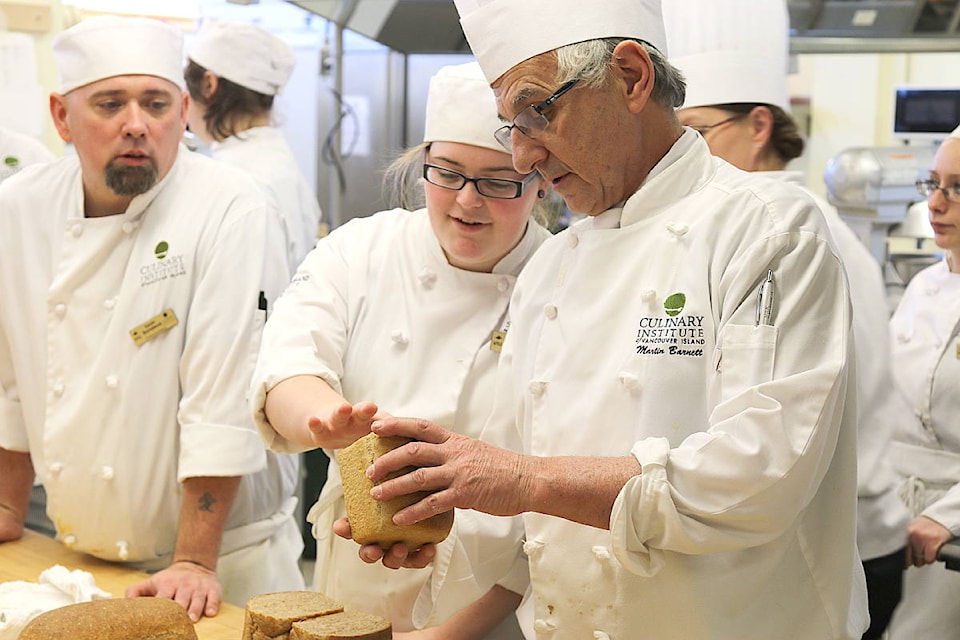Aspiring bakers and pastry chefs in the Vancouver Island University (VIU) main kitchen on the Nanaimo campus gather around eight fresh loaves of bread but something doesn’t smell quite right and that’s precisely the lesson at hand.
“The point of the cause and effect class is to make changes to the recipes without students knowing what we changed,” said Baking and Pastry Arts Program chair Martin Barnett.
“When you introduce a little too much baking soda, too much salt or forget an egg unexpected things happen.”
The Ladysmith resident introduced the teaching method into the curriculum this semester as a creative way to challenge students after a suggestion from an instruction at The School of Artisan Food (SAF) in Nottinghamshire, England.
SAF and VIU participate in student and teacher exchanges which exposed Barnett to the process and hatched the idea.
What it means for them is that one day a week, nothing is going to turn out right.
On this day the bread is baked with different grains like kamut, red fife, spelt, and stone ground whole wheat.
“Go ahead - look at it, smell it, taste it,” Barnett tells his students.
The feedback is almost instantaneous as one student turns up her nose: “This one smells like concrete” as a classmate reacts that “this one tastes like cardboard.”
Among them is first year student Jessica Scott who uses her finger to tap the brick-like loaf of bread in front of her. She carefully cuts into it to begin the process of finding out what happened.
“This class is great because I know I will screw up in the future. When it happens it’s going to be really useful to know why and what I can do to fix it,” said Scott. “It’s about trial and error and I believe it will help reduce mistakes as we move forward.”
Barnett said that instead of trying to achieve perfection with each baking or pastry recipe that students are aware that something will go wrong and are given time to gain an appreciation from what exactly happened.
“Our classroom is a busy commercial kitchen. We produce a wide range of products for our VIU community cafeterias and various events held across campus – and they have to be perfect,” he said.
“For some students a failure is devastating for their self-esteem. Their product comes out wrong and has to be thrown in the trash. By offering this class away from the pressure of production, when mistakes happen they leave knowing why. It’s much easier than trying to figure out what went wrong after the fact.”
VIU’s Centre for Innovation and Excellence in Learning director, Dr. Liesel Knaack, said the introduction of the cause and effect teaching strategy by Barnett is giving baking students the opportunity to co-create their own knowledge and skills through innovative and high impact learning experiences.
“Enhancing teaching and learning practices in the trades and applied technologies is a vital part of successful learning at VIU,” said Knaack. “Martin and his colleagues are designing rich learning experiences to assist students in deeper retention of key competencies of being a successful professional baker.”
Angelique Frederiksen graduated from VIU with her Red Seal baking certification. She is now an instructional assistant in the program and says it’s interesting to watch the students use their senses to deconstruct what was changed in a recipe.
“I can see that the cause and effect class is making things less stressful for our students, which is always a good thing. By taking that production pressure away you learn how to problem solve, which is just as important as the baking, when you are employed full-time in a busy kitchen,” said Frederiksen.
For Barnett, incorporating new teaching styles is exciting, especially when the lesson he brings in teaches something that transcends the kitchen.
“There are 12 steps to making a loaf of bread. Baking is a science and in a busy environment like this mistakes happen all the time,” said Barnett. “Cause-and-effect relationships affect students every day, whether they recognize it or not. To be successful, students need to be aware of their environment and their place in it. Decisions have consequences and if we can make students aware of that they will be better equipped to think analytically in not just their academic lives, but their personal ones as well.”
